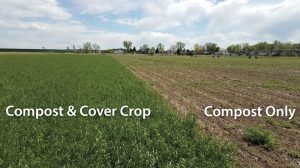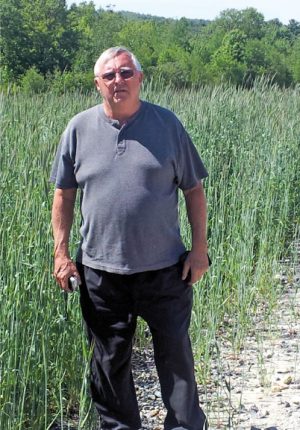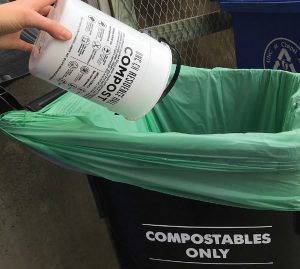BioCycle November/December 2019
 Boulder County, Colorado: Compost Being Tested For Carbon Sequestration
Boulder County, Colorado: Compost Being Tested For Carbon Sequestration
In early 2019, the Boulder County Parks and Open Space and Colorado State University (CSU) teamed up to design a carbon farming experiment on the 120-acre Campbell & Quicksilver Farm outside of Longmont. Boulder County purchased the Quicksilver Farm Property (the eastern three-fourths) in 1995. The Campbell Property (the western fourth) was purchased in 2000. These two properties have been leased to Paul Schlagel and Scott Schlagel since 2006. Ten acres, split into four sections, are being used for the carbon sequestration experiment. Five proven carbon-sequestering techniques identified for the study with CSU include: Tillage reduction; Use of slow release fertilizers/nitrification inhibitors; Utilizing compost amendment; Cover crops; and Planting windbreaks. The Schlagels already incorporate tillage reduction and use of slow release fertilizers/nitrification inhibitors. This project allowed the county and the farmers to share in the cost of two additional techniques: utilizing compost amendment and cover crops.
In late February, the farmers hauled and spread EcoGro Compost (Class 1) from A-1 Organics in Keenesburg, Colorado. The compost was applied at 16 tons/acre to two 5-acre subsections of the property. The compost covered the ground at about three-eighth inches deep. On March 1, a cover crop of two species, rye and hairy vetch, was drilled into two 5-acre subsections of the property. By splitting the cover crop seed over the compost and adjacent control plots, there are two replicates of 2.5-acre blocks with and without compost and cover crop. This process is designed to show the effects of compost and cover crops on the performance of the 2019 corn crop and the subsequent crops.
In mid-May, corn was planted on the Campbell and Quicksilver Properties. The cover crop of rye and hairy vetch grew well in the spring, reports the County, and after 2.5 months of growth, the cover crops were sprayed with an herbicide just prior to emergence of the corn seedlings. Throughout the summer the corn plots were irrigated regularly by the lateral sprinkler and had a good growing season. The farmers and county staff continue to monitor resulting effects on the soil and crops from the different treatments (the control plot, the compost plot, the cover crop plot, and the compost and cover crop plot). In August, the Ag Resources Division completed a soil health assessment with volunteers.
In late September, the corn was harvested as forage for a local dairy. Staff also collected ears of corn, raw silage, and soil samples from the carbon sequestration treatments for lab analysis. The lab results help CSU, staff and farmers to make plans for future compost additions and to see if there were differences in the treatments within the first year. While the levels of carbon in the soil rose slightly for those that used compost and cover crops, Blake Cooper, the agricultural resources division manager for Boulder County Parks and Open Space, has not seen a statistically significant difference between the soils on any of the plots. “It’s trending in the right direction,” Cooper told the Times-Call newspaper. “The carbon is highest in some of the compost treatments. That was expected in the first year, which is why it’s a five-year study.”
St. Paul, Minnesota: Interactive Organics Locator Map
The Minnesota Pollution Control Agency (MPCA) collaborated with the Minnesota Composting Council (MNCC) to create and publish an interactive organics locator tool that provides users with a map showing Minnesota’s permitted yard trimmings and source separated organics composting sites. Map users can see the contact information for the sites and be directed to their web page. Options for searching include the Near Me function — enter your zip-code, city or county to find a location near you — and the Search Bar function — enter the facility name or permit number in the search field. The mile radius in the search can be expanded using a mile slider bar. By clicking an icon inside the map, details about the site appear.
MPCA and MNCC explain that the layers icon shows the Minnesota Department of Agriculture’s quarantine areas and general infestations for emerald ash borer (EAB). Once this layer is active, the legend will display information about these areas. The filter can also be used to select compost types. Users of the locator tool are advised to call the site or visit its website to learn if it’s open for material drop-offs or if the finished product is for sale. Some sites only accept certain types of materials, are only open to residents of their host community, or have limited hours of operation.
Westminster, Massachusetts: Remembering Bill Page, Mass Natural
 William S. Page, Sr. passed on October 1, 2019 at the age of 76, following a short illness. Bill was a pioneer of industrial scale composting, owning Mass Natural Fertilizer Co. (MNFC) in Westminster, one of the largest organic waste recycling facilities in the Northeast. The composting facility was originally established in 1987 to compost chicken manure from an 800,000 bird layer operation. With a background in horticulture and golf course construction and management, Bill was hired to operate the composting facility, and when the farm went out of business in the early 1990s, he purchased it and expanded the composting facility to process a wide range of source separated industrial organics, including cranberries from juice manufacturers in southeast Massachusetts and paper fiber from paper mills.
William S. Page, Sr. passed on October 1, 2019 at the age of 76, following a short illness. Bill was a pioneer of industrial scale composting, owning Mass Natural Fertilizer Co. (MNFC) in Westminster, one of the largest organic waste recycling facilities in the Northeast. The composting facility was originally established in 1987 to compost chicken manure from an 800,000 bird layer operation. With a background in horticulture and golf course construction and management, Bill was hired to operate the composting facility, and when the farm went out of business in the early 1990s, he purchased it and expanded the composting facility to process a wide range of source separated industrial organics, including cranberries from juice manufacturers in southeast Massachusetts and paper fiber from paper mills.
I first met Bill when my compost consulting business was working for a paper mill that wanted to recycle its short paper fiber, or SPF. As the only composting facility permitted in Massachusetts to compost SPF, I made arrangements with Bill to conduct a pilot project. MNFC has served as the primary recycling outlet for a number of Massachusetts paper mills, including Seamen Paper, and Newark America, diverting thousands of tons of organic waste from landfills, and creating a range of compost products, primarily “Top Shelf,” a blend of loam and compost that is sold to garden centers in the greater Boston area. Bill’s connections with the golf course industry led to development of markets for compost in that industry, as well as for many athletic fields including the New England Patriots.
In 2016, Bill’s son, William S. Page, Jr. and his wife Diane, bought MNFC, and continue to operate it. As a composting pioneer, Bill invested in a range of equipment, from windrow turning machines to rotary drums, and eventually concluded that the low-tech, lower cost approach of using front-end loaders to mix materials, and turn piles, was most economical. With its remote hilltop location on over 200 acres, Bill was able to recycle numerous organic materials without creating nuisance odors for neighbors. One of the most challenging materials was gelatin from animal by-products, but with adequate carbonaceous bulking materials, and odor control agents, the material was successfully transformed into a marketable product.
Bill was not known for public speaking, but shared his composting experience with numerous other facilities regarding odor control, and product marketing. He would say, “I stay up here on the hill and mind my own business.” Bill showed New England how to recycle organic waste in a cold, wet climate. — Bob Spencer, BioCycle Contributing Editor.
Chapel Hill, North Carolina: Campus Residential Hall Composting
The University of North Carolina (UNC) at Chapel Hill established its Residence Hall Composting Program in the spring semester of 2014, which consisted of an opt-in program in four residence hall communities on campus. The initiative emerged under supervision of UNC-Chapel Hill’s Office of Waste Reduction and Recycling (OWRR) in conjunction with the University’s Residence Hall Association. The pilot received funding from a state agency compost grant. Undergraduate participants attend educational events at the start of each semester, and receive small airtight containers to collect food waste in their rooms. Once full, students take their containers to centralized cart sites outside the residence halls. These carts are serviced by a student intern or crew members of the OWRR twice a week. By Fall 2016, the program ballooned to 11 residence halls, and then to 22 locations by 2017. The volume of organics increased accordingly, from 1,426 pounds in 2016-17 to 2,433 pounds in 2017-2018 to 4,395 pounds in 2018-2019. In August and September of 2019, more than 1,900 pounds of organic waste have been collected, continuing trends of growth.
For the pilot and first full year of the Residence Hall Composting Program, the separated organics were composted by the Carolina Campus Community Garden (CCCG). The CCCG initiative was established by the North Carolina Botanical Garden, and is mainly operated by local volunteers from UNC and the surrounding town. Its produce is donated directly to UNC employees to promote food security. In 2016, organics collected from the residence halls were folded into the rest of UNC’s food waste recycling program, which utilizes Brooks Contractor for collection and composting services. This enabled the residence hall program to begin collecting additional materials, such as soiled paper, meat, dairy and compostable serviceware from the dining halls and local eateries.
Due to the residence hall program’s rapid expansion, OWRR is keeping it as an opt-in service, limiting potential contamination and ensuring student commitment. The wide range of accepted materials works in tandem with Carolina Dining Services’ initiatives to increase use of compostable takeout containers, cups, and utensils. The Residential Hall Composting Program also falls in line with the University’s campus-wide Three Zeros Environmental Initiative — net zero water usage; zero waste to landfills; and net zero greenhouse gas emissions.
Residence hall composting is happening on many other campuses (first tracked in BioCycle in 2015). In January 2019, for example, Syracuse University’s (Syracuse, NY) Sustainability Management launched a Student Composting Program pilot for South Campus residents. The program ran for 10 weeks and about 100 pounds of food scraps were diverted from the waste stream and delivered to the Onondaga County Resource Recovery Agency (OCRRA) Composting Facility. More than 100 students are now participating across South Campus. Based on their apartment location, participating students have an assigned day for pick-up of their compost bucket, which are swapped out for a clean bucket during collection. The fall 2019 program has exceeded expectations, reports Sustainability Management. In the first four weeks, 526.4 pounds of food scraps were diverted. — Drew Mouw, BioCycle Contributor
New York, New York : Servicing Vendors On Governors Island
Earth Matter NY, Inc. is a nonprofit organization dedicated to advancing the art, science and application of composting in and around New York City. Based on Governors Island, a 172-acre island in the heart of New York Harbor, and only 800 yards from Lower Manhattan, its work is focused on four primary areas: Compost Learning Center, training programs for youth and adults, zero waste initiatives, and a composting operation. During the island’s public season, which runs from May to September, hundreds of thousands of visitors explore the park and participate in events. In open season 2019, Earth Matter’s Zero Waste Island team processed a total of 104,997 pounds of food scraps and compostable service ware, reports the organization. “We also expanded our collection program with vendors and public sorting stations, diverting almost double the amount of food scraps we processed from Governors Island’s visitor and vendor streams in 2018.”














